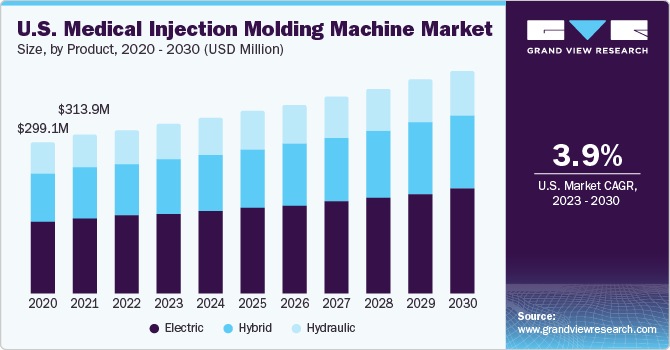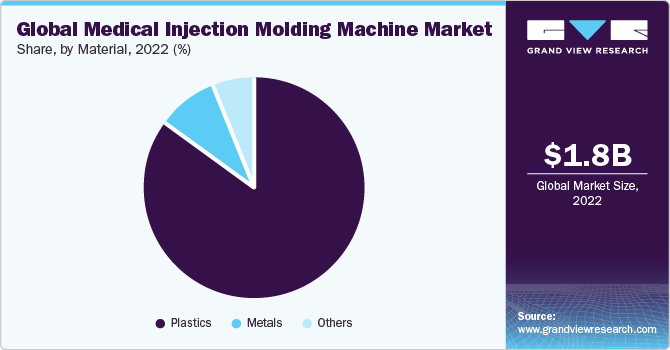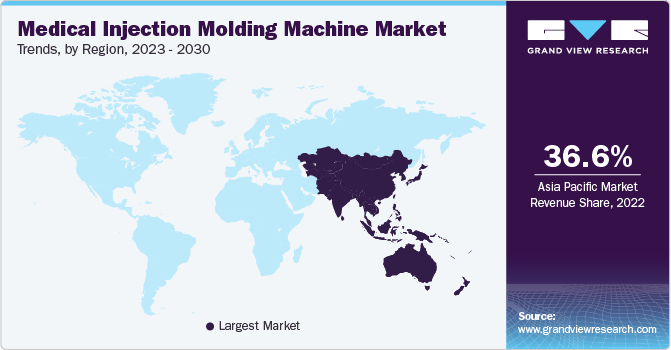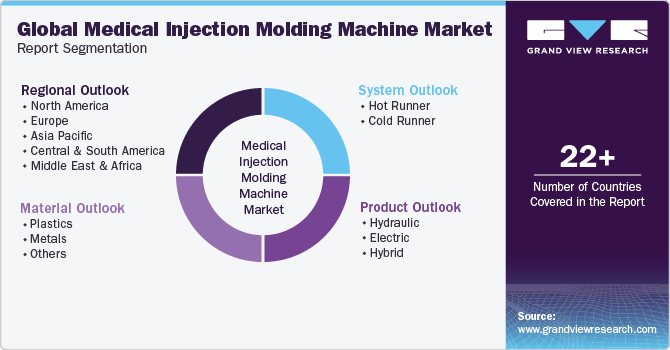
Medical Injection Molding Machine Market Size, Share & Trends Analysis Report By Product (Hydraulic, Electric), By System (Hot Runner), By Material (Plastics), By Region, And Segment Forecasts, 2023 - 2030
- Report ID: GVR-4-68039-920-6
- Number of Report Pages: 169
- Format: PDF
- Historical Range: 2018 - 2021
- Forecast Period: 2023 - 2030
- Industry: Advanced Materials
Market Size & Trends
The global medical injection molding machine market size was estimated at USD 1.81 billion in 2022 and is anticipated to expand at a compound annual growth rate (CAGR) of 4.7% from 2023 to 2030. Rising plastic consumption in healthcare applications, technological innovations, and growing demand for medical disposable products are major drivers for market growth. Other factors include a rise in the prevalence of cardiovascular & respiratory disorders, rising awareness regarding the medical injection molding process, and improvements in the healthcare infrastructure in emerging economies. The adoption of innovative practices in medical & healthcare sectors and development of more effective medical care products & devices are projected to positively impact global healthcare services.

In addition, rising disposable income in the United States is poised to help the country's population in availing advanced healthcare services and using improved products, which is expected to drive healthcare expenditure. These factors are poised to drive market demand through 2030. The demand for medical injection molding machines has witnessed a substantial increase due to various factors contributing to the growth of the healthcare sector. Medical injection molding is vital for producing precise and intricate components used in medical devices. The need for sophisticated medical equipment, along with the trend of utilizing single-use disposable products and the push for customization are key drivers of this demand.
The medical injection molding machines industry growth in the U.S. has been robust, driven by several factors within the healthcare and manufacturing sectors. The medical device industry in the U.S. is one of the most advanced worldwide, having an extensive presence of state-of-the-art manufacturing technologies. The country is a hub for medical device innovation, leading to the constant development of advanced medical devices. Injection molding machines are required for producing intricate components that are integral to these innovative medical devices. Moreover, stringent regulatory standards by agencies lsuch as the FDA necessitate precision and consistency in manufacturing medical devices. Injection molding machines aid manufacturers in meeting such high-quality standards, ensuring the safety and efficacy of medical products.
One significant example lies in the production of syringes and other disposable medical components. The demand for safety syringes with advanced features, such as retractable needles, requires precise & high-quality molding, which is efficiently achieved through medical injection molding machines. These machines enable the mass production of intricate parts with tight tolerances, addressing the industry's stringent quality as well as regulatory standards. Moreover, the rising prevalence of chronic disorders in the U.S. has led to a strong demand for diagnostic & monitoring devices. Equipment such as glucose meters, inhalers, and various monitoring devices generally rely on injection-molded components.
Medical injection molding machines enable the production of these components with the required precision and consistency, contributing to the efficiency and reliability of these critical healthcare devices. According to the U.S. Centers for Medicare & Medicaid Services, the medicare spending increased by 8.4% to USD 900.8 billion in 2021. Furthermore, Medicaid spending grew by 9.2% to USD 734.0 billion in 2021. The consistent growth in the healthcare expenditure of the United States has led to substantial investments in advanced medical technologies. Medical injection molding machines enable efficient and cost-effective large-scale production, addressing the economic considerations of the healthcare sector. These factors are expected to propel the demand for the market for medical injection molding machines.
Material Insights
The plastics material segment led the market and accounted for 85.0% of the global revenue share in 2022. Plastic injection molding is a viable approach for producing complex medical products. Medical-grade injection-molded products are in huge demand because they are long-lasting, inherently resistant to pollutants and chemicals, and provide economies of scale to major manufacturing companies. Owing to their high metal tolerance, tensile strength, and temperature endurance, engineering-grade plastic resins are useful in the manufacture of medical and pharmaceutical items.

Furthermore, they cut waste, weight, and total production costs, consequently adding to industry growth. The metal material segment is expected to witness a CAGR of 6.2% over the forecast period. Metal injection molding machine is suitable for manufacturing intricate, small, and precision metal components required by the medical industry. The metal injection molding process uses a combination of thermoplastic and powder metallurgy injection molding. Risk of corrosion, large amount of wastage, and difficulty in producing complicated medical parts are some factors impeding market growth.
Compared to other traditional fabrication techniques, the use of raw materials, labor costs, and inventory costs are reduced by the metal injection molding machine, making it a relatively more cost-effective technology. Moreover, products created utilizing this process frequently exhibit superior mechanical qualities to alternative powder metal castings & parts. In addition, these goods have a high sintered density and small particle size that will be advantageous to producers of components with remarkable mechanical qualities.
Regional Insights
Asia Pacific region dominated the market and accounted for a revenue share of 36.6% in 2022. The healthcare industry in Asia Pacific is expected to witness steady growth over the forecast period. Major factors contributing to the growth include expanding healthcare infrastructures, such as hospitals and clinics, an increasing number of people opting for home care facilities, and rising medical tourism in the region. Moreover, a growing population and an increasing elderly population are other factors boosting the demand for medical products, which, in turn, is anticipated to drive the demand for medical injection molding machines to manufacture various medical products.

Changing demographic and epidemiological trends in Middle East & Africa are pushing the need for healthcare services, which is anticipated to boost the demand for medical devices. This, in turn, is driving the demand for injection molding for producing numerous medical products in the coming years. With healthcare demand outpacing the availability of resources, healthcare costs have increased substantially on account of improving the capabilities of clinics/hospitals. This has increased the demand for medical practitioners, thereby surging the demand for medical devices.
Central & South America is expected to witness a CAGR of 4.9% over the forecast period. The continuously increasing elderly population in Central & South America is expected to result in greater medical needs, in turn, boosting the healthcare industry. This, in turn, is anticipated to augment the demand for medical injection molding machines in the region. The growth of the plastic industry in the country is expected to drive the market Plastic industry comprises resin manufacturers, additive suppliers, and machine manufacturers, all of which supply a wide range of plastic resins, such as polystyrene, polypropylene, polyethylene, PVC, and PET, which are further used in injection molding components.
Increasing demand for minimally invasive surgeries in North America has led to a high demand for medical injection molding machines used for such surgeries. In addition, the region has witnessed a high demand for micro-molding products used to manufacture small parts, such as implants, sensors, tubes, micro-optics, and catheter tips. These micro-molded products are slowly replacing machined components due to their rising demand for minimally invasive surgeries. Thus, the demand for injection molded products is growing due to the increasing demand for surgeries and the rising number of patients suffering from health diseases.
Product Insights
The electric segment accounted for the highest revenue share of 46.6% of the market in 2022. Electric medical injection molding machines feature advanced electric servo drive systems, which offer precise control over the injection process, so that production of intricate and high-quality medical components can be ensured. As the healthcare sectors continues emphasizing on innovation and strict quality standards, the adoption of electric injection molding machines in medical manufacturing is expected to grow, driven by their ability to improve repeatability, drive down energy consumption, and meet specific requirements of medical applications.
The hybrid product segment is poised to advance at a CAGR of 5.7% over the projection period. Hybrid machines integrate electric servo technology's precision with the power & cost-effectiveness of hydraulic systems seamlessly, making them highly suitable for medical device manufacturing. This approach enhances energy efficiency, speed, and precision, which are vital for producing intricate and high-quality medical components. As the medical sector continues its expansion with a focus on sustainability and innovation, the demand for hybrid injection molding machines is poised to rise, driven by their ability to deliver a balance of flexibility, performance, and cost-effectiveness.
When compared to hydraulic machines, electric types are cleaner, faster, tighter, and more repeatable process manufacturing equipment with little waste, resulting in an average energy reduction of roughly 75%. They are favored over hydraulic machines for producing products, such as heart pump parts, orthopedic devices, custom knee braces, catheters, and fetal heartbeat monitors, among others, since they are cleaner in operation. Hydraulic type is a very effective method of making medical devices that meet today's industry demand. However, manufacturers are under pressure to make medical devices faster and at a lesser cost, which has allowed hybrid injection molding machines to play an increasingly important role in medical device manufacturing.
System Insights
The hot runner systems segment held the largest revenue share of around 56.9% in 2022. This machine facilitates the injection molding process by maintaining a constant temperature in the molds, reducing material waste, enhancing efficiency, and improving the overall quality of product. The increasing trend of precision and high-volume production has driven the demand for hot runner systems, as manufacturers look to optimize their production processes and address strict quality standards. Additionally, advancements in technology, such as the integration of smart controls and better energy efficiency, contribute to the rising deployment of hot runner machines in several industrial applications.
The cold runner system segment is expected to advance at a CAGR of 4.0% through 2030. The cold runner system in medical injection molding machines offers various advantages. It minimizes material waste by enabling the reuse of cold runner material, improving cost-efficiency. Additionally, it facilitates precise control over injection parameters, ensuring the development of consistent and high-quality medical components. The cold runner system is especially beneficial to mold temperature-sensitive materials, as it aids in preventing material degradation during the process. Moreover, its design allows for faster cycle times, enhancing overall productivity in medical manufacturing while maintaining required quality standards.
The use of a cold runner system is based on its benefits, such as ease of maintenance and cost-effectiveness. It is suited for a wide range of polymers. This technology is a viable choice as it produces higher-quality parts. As a result of reduced initial investments compared to other systems, the use of cold runner systems is increasing at a rapid pace. Moreover, a cold runner system is a physical tube that is not heated and is used to inject plastic through a sprue. Its mold base is made up of two or three plates. The injection technique employs molten thermoplastic, which is injected into the molds through a nozzle via a sprue. Runners are kept at the same temperature as molds in this system.
1h. The metal material segment is expected to witness a CAGR of 6.2% over the forecast period. Metal injection molding machine is suitable for manufacturing intricate, small, and precision metal components required by the medical industry. The metal injection molding process uses a combination of thermoplastic and powder metallurgy injection molding. Risk of corrosion, large amount of wastage, and difficulty in producing complicated medical parts are some factors impeding market growth.
Compared to other traditional fabrication techniques, the use of raw materials, labor costs, and inventory costs are reduced by the metal injection molding machine, making it a relatively more cost-effective technology. Moreover, products created utilizing this process frequently exhibit superior mechanical qualities to alternative powder metal castings & parts. In addition, these goods have a high sintered density and small particle size that will be advantageous to producers of components with remarkable mechanical qualities.
Key Companies & Market Share Insights
To increase market penetration and meet changing technical demands, key manufacturers use a variety of methods, such as geographical expansions, product launches, and mergers & acquisitions. For instance, in June 2023, Husky installed a medical molding system in India, which will be used for blood collection tube production. In December 2022, The Japan Steel Works, Ltd. launched JLM3000-MGIIeL. The new machine enables high-quality molding and high precision of large magnesium parts and supports customers in making their production line eco-friendly.
Key Medical Injection Molding Machine Companies:
- Sumitomo (SHI) Demag Plastics Machinery GmbH
- Milacron MSA
- Engel Machinery India Pvt. Ltd.
- Husky Injection Molding Systems Ltd
- Arburg GmbH + Co KG
- HARBEC
- Metro Mold & Design
- Proto Labs, Ltd.
- AMS Micromedical, LLC
- The Japan Steel Works, Ltd.
- KraussMaffei Group
- UBE Machinery
- Toshiba Machine Co., Ltd.
- Wittmann Battenfeld
- Hillenbrand, Inc.
Medical Injection Molding Machine Market Report Scope
|
Report Attribute |
Details |
|
Market size value in 2023 |
USD 1.89 billion |
|
Revenue forecast in 2030 |
USD 2.61 billion |
|
Growth rate |
CAGR of 4.7% from 2023 to 2030 |
|
Base year for estimation |
2022 |
|
Historical data |
2018 - 2021 |
|
Forecast period |
2023 - 2030 |
|
Report updated |
October 2023 |
|
Quantitative units |
Revenue in USD million/billion, and CAGR from 2023 to 2030 |
|
Report coverage |
Revenue forecast, company market position analysis, competitive landscape, growth factors, and trends |
|
Segments covered |
Product, system, material, region |
|
Regional scope |
North America; Europe; Asia Pacific; Middle East & Africa; Central & South America |
|
Country scope |
U.S.; Canada; Mexico; Germany; France; Italy; UK; Spain; China; India; Japan; South Korea; Australia; Brazil; Argentina; Saudi Arabia; South Africa |
|
Key companies profiled |
Sumitomo (SHI) Demag Plastics Machinery GmbH; Milacron MSA; Engel Machinery India Pvt. Ltd.; Husky Injection Molding Systems Ltd.; Arburg GmbH + Co KG; HARBEC; Metro Mold & Design; Proto Labs, Ltd.; AMS Micromedical, LLC; The Japan Steel Works, Ltd.; KraussMaffei Group; UBE Machinery; Toshiba Machine Co., Ltd.; Wittmann Battenfeld; Hillenbrand, Inc. |
|
Customization scope |
Free report customization (equivalent up to 8 analysts working days) with purchase. Addition or alteration to country, regional & segment scope |
|
Pricing and purchase options |
Avail customized purchase options to meet your exact research needs. Explore purchase options |
Global Medical Injection Molding Machine Market Report Segmentation
This report forecasts revenue growth at global, regional, and country levels and provides an analysis of the latest trends in each of the sub-segments from 2018 to 2030. For this study, Grand View Research has segmented the global medical injection molding machine market report on the basis of product, system, material, and region:

-
Product Outlook (Revenue, USD Million, 2018 - 2030)
-
Hydraulic
-
Electric
-
Hybrid
-
-
System Outlook (Revenue, USD Million, 2018 - 2030)
-
Hot Runner
-
Cold Runner
-
-
Material Outlook (Revenue, USD Million, 2018 - 2030)
-
Plastics
-
Metals
-
Others
-
-
Regional Outlook (Revenue, USD Million, 2018 - 2030)
-
North America
-
U.S.
-
Canada
-
Mexico
-
-
Europe
-
Germany
-
France
-
Italy
-
UK
-
Spain
-
-
Asia Pacific
-
China
-
Japan
-
Australia
-
India
-
South Korea
-
-
Central & South America
-
Brazil
-
Argentina
-
-
Middle East & Africa
-
Saudi Arabia
-
South Africa
-
-
Frequently Asked Questions About This Report
b. The global medical injection molding machine market size was estimated at USD 1.81 billion in 2022 and is expected to be USD 1.89 billion in 2023.
b. The medical injection molding machine market, in terms of revenue, is expected to grow at a compound annual growth rate of 4.7% from 2023 to 2030 to reach USD 2.61 billion by 2030.
b. Asia Pacific region dominated the market in 2022 by accounting for a share of 36.6% of the market. Healthcare industry in Asia Pacific is expected to witness steady growth over the forecast period. Moreover, a growing population and increasing elderly population are other factors boosting the demand for medical products, which, in turn, is anticipated to drive the demand for medical injection molding machine to produce numerous medical products.
b. Some of the key players operating in the medical injection molding machine market include Sumitomo (SHI) Demag Plastics Machinery GmbH, Milacron MSA, ENGEL MACHINERY INDIA PVT. LTD., Husky Injection Molding Systems Ltd, Arburg GmbH + Co KG, HARBEC, Metro Mold & Design, Proto Labs, Ltd., AMS Micromedical, LLC, The Japan Steel Works, LTD, KraussMaffei Group, UBE Machinery, Toshiba Machine Co., Ltd., Wittmann Battenfeld, Hillenbrand, INC.
b. Increasing consumption of plastics in healthcare applications, technological advancements and rising demand for medical disposable products are the major factors driving the growth of the market.
We are committed towards customer satisfaction, and quality service.
"The quality of research they have done for us has been excellent."




